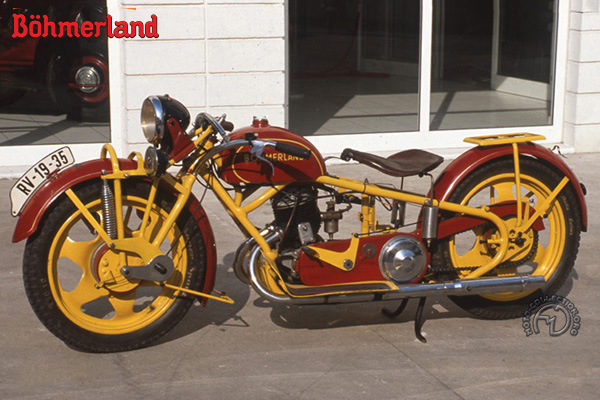
Photo ou archives : D. Ganneau
5816
BÖHMERLAND
350cc 1937
Bohemian rhapsody
Designed by Albin Liebisch, the Böhmerland (German for "Bohemia") was also sold under the Czechoslovakian name "Cechie." Made at Schönlinde and subsequently Schluckenau-Kunratice, in the Sudetenland region of Northern Bohemia, they sold best on their home ground and over the German border in Saxony and Silesia. The main reason for this was that Liebisch had no sales networks and all repair work was carried out by the factory.
Solidly Non-Conformist
Liebisch created a highly-original motorbike in 1925 that scarcely changed during the company's 14 years of existence. The engine was a long-stroke ohv 538cc single. Over the years the output went up from 16 to 25 hp.
Low Center of Gravity
The main feature of this machine the sole model of the marque until 1937 was its tubular double-cradle frame, which gave a very low center of gravity, especially in the three-seated long-wheelbase model. At around 10 ft overall, it was the world's longest motorbike. Its cast-aluminum wheels were a feature that would not be seen on another production bike for half a century. A short-wheelbase version competed in hill-climbs. A new model with a 350cc two-stroke engine mounted in a frame very much like that of the 600 appeared in 1937. Its wheels retained the same distinctive appearance as the cast-alloy originals but were now steel pressings with riveted-on rims. The annual production was around 80 units. Fewer than 1,000 Böhmerlands were built between 1925 and 1938, for their specification was hardly likely to appeal to the masses.
SPECIFICATIONS
Engine: 345cc (76x76mm) air-cooled single-cylinder
Power Rating: 12.2 hp @ 3,000 rpm
Valves: two-stroke; twin exhaust ports
Fuel System: carburettor
Transmission: 3-speed, chain final drive
Suspension: leading-links (front); rigid (rear)
Brakes: drum (front & rear)
Wheels: 3.50x19 inch pressed-steel discs with riveted-on rims (front & rear)
Weight: 331 lb
Maximum Speed: 56 mph
Heavy but solid, the 350 Böhmerland followed the same unconventional lines as the 600. WWII brought production to an end.